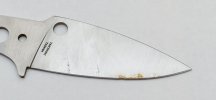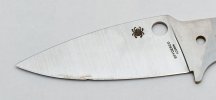- Joined
- Jun 23, 2012
- Messages
- 2,398
If only!
The BladeForums.com 2024 Traditional Knife is available! Price is $250 ea (shipped within CONUS).
Order here: https://www.bladeforums.com/help/2024-traditional/
yep i read that wrong. thanks for pointing me in the right direction.I believe he meant that it should arrive @ Sypderco tomorrow.
It's going to probably take them a while to check out the material.
They won't have a guy in the back staring a screen and saying "enhance".
i already had an iq test this year......Yes, its going to take time.
There might be a Voight-Kampff test as well.
Yes, its going to take time.
There might be a Voight-Kampff test as well.
Is that to check if the Mule is a Replica(nt)?
It's to check if it's an android. My phone already failed

It's to check if it's an android. My phone already failed
This has ever so slightly bummed me out a little about LC200N, if it turns out it's stainless ability is dependent on an absolute 100% perfect heat treat - how are you to know the one you have isn't defective until you see it staining. I'm still excited about the steel because i know Spyderco work on things until they perfect it, but can't say i'd trust it as much from other makers if it becomes widely used.
Cool your jets.
Unless I missed it, we havent heard from Spyderco yet.
Everybody can make a mistake but lets not quite yet break out the torches nor jump to conclusions prior to having heard from Spyderco.



Thanks for taking the time to do this for us. I agree that they results are not what I expected to see, and I would think that many would agree.So I ended my test early, as the results were getting fairly obvious. Pictures below and attached.
I had the knife submerged in water with salt dissolved to the saturation point. This definitely constitutes abuse of the knife - that level of salt is completely unrealistic in any real world situation - so please consider this a worst case scenario. I'm certainly not suggesting that this would happen to any LC200N knife under any normal scenario.
The knife was straight from Spyderco, wiped with alcohol to remove any oil, and then submerged in salt water for 4 days. Afterwards, I rinsed it and wiped it with a cloth - nothing more aggressive. Weirdly, it had just one area of damage, but that area was pretty bad:
View attachment 863892
Big rust stain, and multiple chips in the edge that weren't there when I submerged the knife.
Full pictures of the blade are attached. The black streaks are gunk from when I was testing the remaining edge cutting through cardboard, including tape. What's odd is that the rest of the knife, including the edge, held up very well - dare I say, perfectly. That's kind of inline with what the OP shows - certain areas of heavy staining, while the rest of the blade appears fine. Contrast that to the corrosion test videos from Cedric and Ada or BladeHQ, where the knives that did rust had staining and speckling evenly distributed across the surface of the blade.
View attachment 863891 View attachment 863893
So, I dunno what to make of it. Most of the blade was fine, but one spot got destroyed. There were some theories earlier in the thread that the rust spots might be from inclusions in the metal, either from the refinery itself, or from the grinding process. Zknives lists LC200N as manufactured using the electroslag remelting process (description here: http://www.zknives.com/knives/steels/steeltec.shtml#ESR) which certainly sounds like it may be prone to inconsistencies in the final product, but I'm just guessing from their brief description.
What's also interesting is that we now have three examples (the OP's comments, plus the Cedric and Ada, BladeHQ videos referred to earlier) where the Spydiechef held up much better to corrosion testing. In particular, BladeHQ had a SpydieChef submerged Great Salt Lake water, which likely isn't too far off from what I was testing with, especially once some of their water evaporated and concentrated the salt. As I mentioned in an earlier post, the mule and the Spydiechef are made in different facilities, on different continents, so there could be any number of factors that would lead to
different results.
Just based on this, I'd have to conclude the following:
Hopefully we'll know more once the Caribbean launches. The Spydiechef was a bit of a specialty knife - I'm hoping the Caribbean sees more use in salt water conditions so we can get more real-world data.
- LC200N appears to be generally more stain resistant than regular stainless steels
- With data from two production batches (the mule and Spydiechef), I don't think we have enough data to start figuring out the inconsistencies. Hopefully Spyderco can learn more once they get the OP's blade, and subject it to additional testing. I'm hoping some Spyderco Tusk users can chime in as well
- Spyderco's warranty and customer service are excellent, as the OP found. If you do buy an LC200N blade, and it corrodes under normal use, it sounds like they'd replace it. Based on that, I wouldn't really have any major concerns buying a Spydiechef or Caribbean for use in salty conditions
To add, I was also testing an AEB-L blade and a Vanax blade at the same time. The AEB-L blade got destroyed in 4 days - the edge was almost completely gone. Not even worth trying to resharpen it - I trashed it. The Vanax blade? Perfect, as if nothing happened. That may support the theory that the problem is due to inclusions or inconsistencies in the steel manufacturing process, as Vanax is a powder steel, which should lead to a much more even distribution of the components.
Thanks for taking the time to do this for us. I agree that they results are not what I expected to see, and I would think that many would agree.
I am still looking forward to my first knife in LC200N, and these slight stains (across all knives shown/referenced) haven't tempered the desire. I am fine with M4, so LC200N should be plenty stainless.
